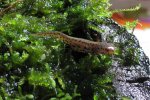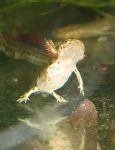Azhael
Site Contributor
- Joined
- May 7, 2007
- Messages
- 6,644
- Reaction score
- 121
- Points
- 0
- Location
- Burgos
- Country
- Spain
- Display Name
- Rodrigo
At that size they can certainly manage bloodworms, i´m already feeding small ones to my larvae and they are younger. You´ll probably have to hand feed at first, since with no movement they are unlikely to recognize it as food. Most larvae get used to them fairly quickly and will learn to "hunt" them by smell, which makes things easier because you just have to throw the bloodworms in.
My estimate of morph size was aimed a bit low xD However you have to consider that during metamorphosis, the animal usually suffers a small reduction in size (all the crests disappearing and all the energy used, usually make the morph look smaller). Yours seem to be going to have a very decent size when they morph, which is very nice. It makes everything easier.
I don´t have any data at hand, but it´s a well known fact that temperature, poblational density and food, play a role in metamorphosis sizes. Lower temps usually slow the process, but also allow larvae to grow larger (the extreme version of this is the aforementioned facultative neoteny which is favoured by low temps). Having lots of food around also increases the chances of bigger morphs. Low densities of larvae tend to have the same effect.
I have a question for you, have you seen any cannibalism or agression between the larvae? Mine look like they are waiting to be big enough to devour each other, i swear i saw one circling another
My estimate of morph size was aimed a bit low xD However you have to consider that during metamorphosis, the animal usually suffers a small reduction in size (all the crests disappearing and all the energy used, usually make the morph look smaller). Yours seem to be going to have a very decent size when they morph, which is very nice. It makes everything easier.
I don´t have any data at hand, but it´s a well known fact that temperature, poblational density and food, play a role in metamorphosis sizes. Lower temps usually slow the process, but also allow larvae to grow larger (the extreme version of this is the aforementioned facultative neoteny which is favoured by low temps). Having lots of food around also increases the chances of bigger morphs. Low densities of larvae tend to have the same effect.
I have a question for you, have you seen any cannibalism or agression between the larvae? Mine look like they are waiting to be big enough to devour each other, i swear i saw one circling another







